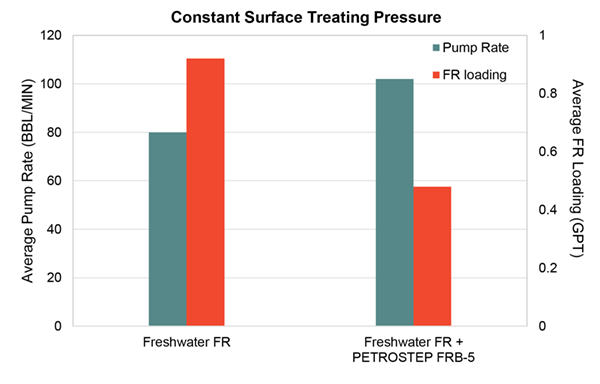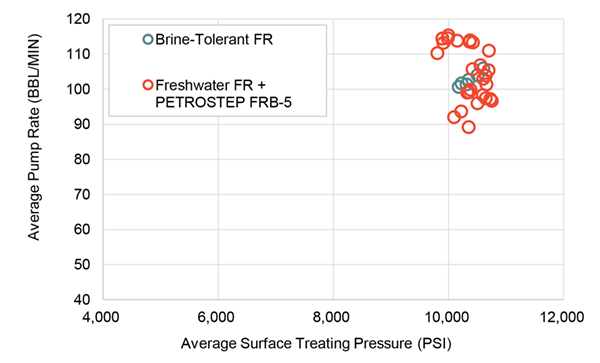Want to know more about PETROSTEP FRB-5?
Download our brochure to learn more.
Enhancing the Performance of Freshwater Friction Reducers in Recycled Water for Oilfield Applications
Hydraulic fracturing requires millions of gallons of water per well placing considerable strain on freshwater resources. A potential solution to this problem is to re-use the water that is produced along with the hydrocarbons to formulate the fracturing fluid.
Enhancing the Performance of Freshwater Friction Reducers in Recycled Water
Hydraulic fracturing is a process employed in the oil and gas industry to extract hydrocarbons from formations that would otherwise be uneconomical due to their low permeability. During this process, fracturing fluid is pumped into the formation through a well at high pressures. This causes the formation to fracture, resulting in high permeability pathways for hydrocarbons to flow into the well.
A key component of the fracturing fluid is a high molecular weight charged polymer — friction reducer (FR) — that allows operators to pump fracturing fluid at high rates while keeping surface treating pressures low. Hydraulic fracturing requires millions of gallons of water per well placing considerable strain on freshwater resources. A potential solution to this problem is to re-use the water that is produced along with the hydrocarbons to formulate the fracturing fluid. This water, termed recycled or produced water, contains a large amount of dissolved salts that adversely affect the performance of the FR.
FR manufacturers have developed salt-tolerant FRs, but they are significantly more expensive than the commodity freshwater FRs. Stepan Oilfield Solutions has developed an innovative solution to address this formulation challenge. PETROSTEP® FRB-5 enhances the performance of freshwater FRs so they can function optimally in highly saline water. These surfactants reduce the customer’s operating cost by enabling the use of recycled water and improve the sustainability of the fracturing operation by reducing strain on freshwater resources.
Rigorous laboratory testing has demonstrated the efficacy of these surfactant formulations with a wide range of anionic and cationic FRs in brines, some having total dissolved solids (TDS) of more than 250,000 mg/L.
Case Study 1
A freshwater FR was used in six slickwater fracturing stages in a well in the Permian Basin. Two stages were completed with the FR alone, while four stages included PETROSTEP FRB-5 at an average concentration of approximately 5% of the FR loading. The mix water contained 90,000 mg/L TDS. The concentrations of the other components of the fracturing fluid — a scale inhibitor and biocide — were held constant throughout. The surface treating pressure was held constant at approximately 8,000 psi to facilitate comparison between stages.
In the stages that employed PETROSTEP FRB-5, the operator was able to increase their pump rates by 25%, while requiring nearly 50% less FR to achieve the same surface treating pressure, resulting in significant operating cost reduction and time savings due to shorter stage durations (Figure 1).

Figure 1: Average pump rates achieved by using a freshwater FR with and without PETROSTEP FRB-5, in a well in the Permian Basin well. PETROSTEP® FRB-5 resulted in 25% higher pump rates at 50% lower FR loading.
Case Study 2
Another field trial in the Permian Basin evaluated the performance of an inexpensive freshwater FR with PETROSTEP FRB-5 compared to a more expensive brine-tolerant FR. The study included 31 fracturing stages in the same well. Six stages were completed using the brine-tolerant FR while 25 stages employed a freshwater FR with approximately 5% PETROSTEP FRB-5 (relative to FR volume). The mix water contained 110,000 mg/L TDS. The concentrations of the other components of the fracturing fluid were held constant between stages.
The two fluid systems performed comparatively when analyzed over the entire study (Figure 2), even though there were variations in treating pressures and pump rates between stages and wells. Additionally, the average FR loadings in the two fluid systems were nearly identical. These results enabled the operator to reduce cost by replacing their expensive brine-tolerant FR with an inexpensive freshwater FR enhanced by a small amount of PETROSTEP FRB-5.

Figure 2: Scatter plot of average pump rates and surface treating pressures from 31 stages in a well in the Permian Basin well. The performance of the freshwater FR with PETROSTEP FRB-5 was indistinguishable from that of the brine-tolerant FR.
Stepan Oilfield Solutions' PETROSTEP FRB-5 surfactant formulations enhance the performance of emulsion-based FRs in brines. They enable operators to formulate their fracturing fluids in recycled and produced waters, resulting in lower cost and more sustainable operations. PETROSTEP FRB-5 improves the performance of low-cost freshwater FRs to match more expensive brine-tolerant FRs. They also help the operator optimize FR dosage, which minimizes the severity of formation damage from the fracturing fluid.
Our formulation experts at Stepan Oilfield Solutions can work with your existing system to quickly tailor a solution for your specific application. Contact us to discuss your formulation needs.




